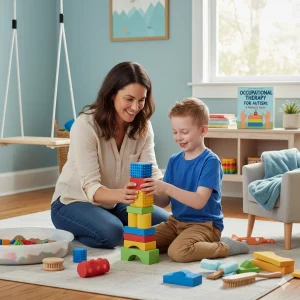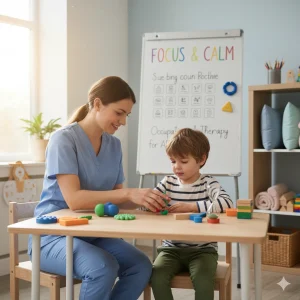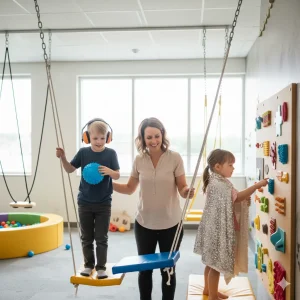Occupational Therapy for 8-Year-Olds: Improve Handwriting & Focus
By Wellness Hub
Last Updated: October 17, 2025
If your 8-year-old is struggling to focus during writing tasks or their handwriting looks messy no matter how much they practice, you’re not alone. Many children at this age find it hard to keep their letters on the line, space their words correctly, or stay engaged long enough to finish assignments. These handwriting struggles are often linked to fine motor skills, executive function, and sensory processing challenges — and that’s exactly where occupational therapy for handwriting can make a life-changing difference.
With the right support, children don’t just learn better letter formation — they build confidence, independence, and a stronger foundation for academic success. In this guide, we’ll explore why handwriting difficulties happen at this age, how occupational therapy helps children improve focus and legibility, and what simple, evidence-based strategies parents can try at home to make writing less frustrating and more fun.
Why Handwriting Challenges Are Common at Age 8
Handwriting is more than just putting pencil to paper — it’s a complex skill that blends fine motor control, visual processing, and cognitive functions like attention and planning. Around age 8, many children start facing new academic demands, which often bring handwriting difficulties to the surface. If your child seems to write slowly, tire easily, or produce messy work despite trying their best, it doesn’t mean they’re lazy or not capable. It may simply mean they need extra support to build the foundational skills behind writing.
Typical Handwriting Milestones for 8-Year-Olds
By this age, most children are expected to:
- Form letters accurately and automatically
- Maintain consistent size, spacing, and alignment
- Use a mature tripod grasp with good pencil control
- Write full sentences with increased speed and legibility
- Copy from the board or a book with minimal errors
If your child is struggling to meet these handwriting milestones at age 8, it’s a good idea to take a closer look at the underlying skills that support handwriting, not just the writing itself.
Signs Your Child May Be Struggling
Some common red flags include:
- Uneven letter sizes or letters that float off the line
- Slow writing speed, making it hard to finish classwork on time
- Holding the pencil too tightly or using an awkward grip
- Avoiding writing tasks, becoming frustrated, or saying “I can’t”
- Complaints of hand fatigue, headaches, or messy papers
These signs often reflect handwriting difficulties in children, which can affect their confidence, classroom performance, and willingness to engage in writing activities.
How Executive Function Affects Writing
One key — and often overlooked — factor in handwriting challenges is executive function. Skills like working memory, attention, planning, and organization play a huge role in how children manage writing tasks.
For example, while copying a sentence, your child must:
- Look at the words.
- Remember them.
- Write them accurately and neatly.
- Stay focused until the task is complete.
If any of these steps are hard, executive function and handwriting may both need targeted support. This is why many occupational therapy programs address not only motor skills but also attention and cognitive strategies to help children stay on track.
Bottom line for parents: handwriting challenges at this age are common — and with the right strategies and support, they can be overcome. Early recognition and help can make a big difference in your child’s confidence and academic success.
Also read: In-Hand Manipulation Skills for Kids: 30+ OT-Backed Activities to Build Fine Motor Control
How Poor Focus Impacts Writing & Classroom Learning
When children struggle to focus during writing tasks, it’s not just about getting distracted—it’s about how their brain processes, plans, and follows through on complex steps. Handwriting requires attention, motor coordination, language skills, and cognitive control to work in sync. For many 8-year-olds, that can be overwhelming, especially in a busy classroom environment. If your child seems to “drift off,” rush through writing, or avoid it altogether, it may be a sign of attention and concentration difficulties that go beyond typical daydreaming.
Attention and Concentration Issues in School-Aged Children
Many children have bursts of focus but struggle to sustain attention long enough to complete structured writing tasks. In class, this can show up as:
- Incomplete or rushed written work
- Difficulty following multi-step instructions
- Frequent erasing, skipping lines, or inconsistent letter formation
- Trouble copying from the board without losing their place
This isn’t a sign of laziness. It’s a signal that your child may benefit from attention and focus therapy for kids, or simple classroom strategies that build stamina and structure. Breaking writing into short, manageable chunks and reducing distractions can make a big difference.
The Role of Working Memory and Planning in Handwriting
To write even a short sentence, children must remember the words, plan how to form each letter, organize spacing, and stay engaged through the task. This is where working memory and executive function come in.
When these cognitive skills are weak, handwriting can look:
- Disorganized, with uneven letter sizes and spacing
- Slow and tiring, because each step requires extra effort
- Incomplete, because the child simply loses track of their place
Strengthening executive function and writing tasks together helps children build better focus, more fluid handwriting, and greater confidence in their work.
Connection to Conditions Like ADHD and Dysgraphia
Sometimes, focus issues may be linked to underlying conditions such as ADHD or dysgraphia.
- Children with ADHD may find it hard to maintain attention long enough to complete writing tasks accurately. This can lead to ADHD handwriting problems like inconsistent sizing, letter reversals, or messy spacing.
- Dysgraphia, a specific learning difference, affects the ability to write clearly and efficiently. It often overlaps with attention challenges, making writing a frustrating experience.
While not every child who struggles with focus has a diagnosis, early support through occupational therapy or targeted classroom strategies can ease this load. With the right guidance, children can build the skills they need to focus, plan, and write with confidence.
Key takeaway for parents: Struggles with focus and handwriting are often connected. Supporting attention and executive function can lead to stronger writing skills and a happier learning experience.
What Occupational Therapy Does for Handwriting & Focus
When handwriting becomes a daily battle—filled with tears, frustration, or messy papers—occupational therapy can make a world of difference. Occupational therapists don’t just teach children to “write neatly.” They help kids build the skills that make writing possible: focus, hand control, coordination, and confidence. For many families, starting occupational therapy for 8-year-olds is the turning point that transforms handwriting from a struggle into a skill.
Pediatric OT Evaluation and Goal Setting
Every child’s handwriting challenge is unique. That’s why a pediatric OT evaluation is the first step. During this assessment, the therapist looks at more than the handwriting sample itself. They observe:
- Posture and core stability
- Fine motor control and hand strength
- Grip patterns and pencil grasp
- Visual-motor integration (how eyes and hands work together)
- Attention and sensory needs during writing tasks
Based on this evaluation, therapists set individualized goals—for example, improving letter formation, increasing writing endurance, or helping the child stay focused for longer periods. These goals are specific, measurable, and tailored to your child’s daily life at school and home.
How Therapists Build Fine Motor and Visual-Motor Integration
Strong handwriting depends on the small muscles in the hands and how well they coordinate with the eyes. Occupational therapists use fun, structured OT handwriting activities to build these skills.
Some examples include:
- Strengthening hand muscles through play-based fine motor activities like tweezers, clay, or pegboards
- Practicing letter formation with multisensory tools like sand trays, chalk, or textured surfaces
- Using visual motor integration activities to help the child align, space, and form letters more consistently
These activities are engaging, age-appropriate, and designed to help your child build writing skills without feeling pressured.
Integrating Sensory Strategies to Support Focus During Writing
For many children, focus issues go hand-in-hand with handwriting struggles. This is where sensory processing and handwriting support come into play. Occupational therapists often integrate sensory strategies into writing sessions, such as:
- Deep pressure or “heavy work” activities before writing to calm the body
- Fidget tools or seat cushions to support attention
- Short movement breaks to maintain alertness
- Adjusting lighting, seating, or paper position to reduce distractions
These strategies help children regulate their bodies, making it easier to sit, attend, and complete writing tasks with less frustration.
Key takeaway for parents: Occupational therapy isn’t just about neat handwriting. It’s about strengthening fine motor skills, improving visual-motor coordination, and using sensory strategies to build lasting focus and confidence. With the right support, your child can make real, measurable progress—both on paper and in the classroom.
Know more: Early Intervention & OT for 3-Month-Old Sensory Growth
Evidence-Based Handwriting Interventions Used by OTs
When handwriting struggles begin to affect your child’s confidence, schoolwork, or daily routines, it’s reassuring to know there are evidence-based occupational therapy interventions that work. Occupational therapists don’t just correct the way letters look — they help children develop the core skills behind clear, efficient writing. These approaches are practical, structured, and designed to support real progress in the classroom and at home.
For many children, handwriting OT for kids can be the key to turning frustration into confidence.
Direct Handwriting Practice vs. Isolated Skill Drills
Research shows that direct handwriting practice produces stronger improvements than isolated fine motor drills alone. This means that while activities like clay squeezing or tweezer games can help build strength, real handwriting practice is what helps children apply those skills to actual writing tasks.
An occupational therapist might use structured programs that focus on:
- Repeated letter formation with visual and verbal cues
- Short, frequent writing sessions instead of long, tiring ones
- Building writing speed and endurance over time
- Real-life writing tasks (notes, sentences, stories) instead of endless worksheets
Curriculum-based handwriting programs are often used because they provide clear structure and consistent routines, helping children gain confidence and fluency.
Pencil Grasp and Posture Training
A stable, functional tripod grasp and good posture are essential for efficient writing. When children hold their pencil too tightly or slump at the desk, their hands tire quickly — and writing becomes a chore.
Occupational therapists work on:
- Encouraging proper finger placement for a tripod grasp
- Adjusting paper angle, desk height, and seating for better alignment
- Using adaptive grips or tools to support correct hand positioning
- Core and shoulder stability exercises to build the foundation for strong handwriting
These seemingly small adjustments can have a big impact on writing speed and legibility, especially for children who fatigue easily.
Task-Specific Handwriting Interventions and Classroom Strategies
Handwriting isn’t just a motor task — it’s a functional skill that needs to work in real classroom settings. That’s why OTs use task-specific handwriting interventions, combining motor skills, attention strategies, and environmental supports.
Some strategies may include:
- Breaking writing assignments into smaller, manageable parts
- Providing visual models or highlighted writing lines
- Allowing alternative tools for children with dysgraphia
- Practicing spacing, alignment, and letter formation directly within classwork
These handwriting interventions for dysgraphia and other challenges are tailored to each child’s strengths and needs, ensuring they can participate fully in learning without feeling left behind.
Key takeaway for parents: Evidence-based handwriting support goes far beyond pretty letters. By combining direct handwriting practice, proper grasp and posture training, and task-specific strategies, occupational therapy helps children build real-world writing skills they can use confidently every day.
OT Strategies Parents Can Try at Home
Helping your child improve their handwriting doesn’t always require special equipment or a therapy center. With the right occupational therapy strategies, parents can support meaningful progress right at home. These activities don’t just make handwriting neater — they build focus, fine motor strength, and confidence. If you’re wondering how to improve handwriting in an 8-year-old at home, these parent-friendly tips are a great place to start.
Simple OT Handwriting Exercises for Elementary Students
One of the most effective ways to build stronger handwriting is through short, consistent practice rather than long, exhausting drills. Start with fun, engaging OT handwriting exercises that keep your child motivated:
- Rainbow tracing: Have your child trace over each letter with different colors to build muscle memory.
- Tactile writing: Use sand, shaving cream, or textured paper to make letter practice more sensory-rich.
- Air writing: Encourage them to “write” letters in the air using large arm movements, which strengthens shoulder and core muscles needed for stable writing.
- Short bursts of copy work: Copying short sentences with breaks helps build both legibility and endurance.
The goal isn’t perfection—it’s building steady progress and confidence.
Sensory Breaks and Movement Strategies to Improve Attention
Children often lose focus during writing because their bodies and minds need a reset. Incorporating sensory strategies for writing can make a big difference. These activities help regulate energy levels, improve attention, and make handwriting less of a struggle:
- Heavy work before writing: Activities like wall pushes, chair push-ups, or carrying something slightly heavy can help calm and focus the body.
- Movement breaks: A quick stretch or walk between writing tasks helps prevent fatigue.
- Fidget tools or wiggle cushions: These can support kids who need to move without disrupting their work.
- Adjusting the environment: Reducing noise, ensuring good lighting, and giving a stable writing surface improves concentration.
These sensory strategies not only help with handwriting but also build better self-regulation skills that support learning in other areas too.
Executive Function Supports for Daily Writing Tasks
Handwriting isn’t just a motor skill—it relies on executive function skills like attention, planning, memory, and organization. Supporting these skills at home can make writing tasks easier and less overwhelming for your child:
- Break tasks into steps: For example, “Write one sentence → check spacing → take a short break.”
- Use visual checklists: This helps children stay on track without constant reminders.
- Set realistic goals: Celebrate small wins to build motivation.
- Keep routines consistent: A regular writing time each day builds structure and predictability.
These OT home program handwriting strategies encourage independence and help your child build writing stamina without feeling pressured.
Key takeaway for parents: Improving handwriting at home doesn’t have to be complicated. By combining simple handwriting exercises, sensory regulation strategies, and executive function supports, you can help your child write more clearly, stay focused longer, and feel proud of their work. Consistency—not perfection—is what truly drives progress.
School-Based OT and Classroom Accommodations
When handwriting challenges affect your child’s classroom performance, parents often wonder where to turn for help. The good news is that many children can receive school-based occupational therapy as part of their learning support. This type of OT focuses on helping students succeed in real classroom environments—not just in therapy rooms—through targeted goals, practical strategies, and smart accommodations.
If your child is falling behind in writing, getting tired quickly, or feeling frustrated during written work, school-based OT may be a key part of the solution.
How to Request a School OT Evaluation (IEP / 504 Plans)
The first step is knowing your rights as a parent. If your child struggles with handwriting, you can request a formal OT evaluation through the school. This typically happens under:
- IEP (Individualized Education Program) – for students who qualify for special education services.
- 504 Plan – for students who need accommodations but may not require special education.
You can submit a written request to the school team outlining your concerns. After the evaluation, if your child qualifies, the occupational therapist will create a personalized plan targeting handwriting and classroom participation.
This process ensures that support is embedded into your child’s school day, making handwriting less overwhelming and more functional.
Typical Handwriting Goals in School OT
Occupational therapy in schools is goal-driven, focusing on helping students access the curriculum effectively. Common occupational therapy goals for handwriting might include:
- Improving letter formation, spacing, and alignment
- Increasing writing speed and endurance for classroom tasks
- Strengthening pencil grasp and posture for functional writing
- Enhancing focus and attention during written assignments
- Supporting self-monitoring and independence in writing activities
These goals are realistic, measurable, and integrated into everyday classroom work rather than isolated drills.
Classroom Supports and Adaptive Tools
A big part of classroom accommodations for handwriting is providing the right supports and tools so your child can keep up with their peers. Occupational therapists often recommend:
- Pencil grips or adaptive writing tools to support better hand positioning
- Slant boards or angled surfaces to improve posture and visual tracking
- Lined or highlighted paper to guide spacing and alignment
- Chunking assignments into smaller parts to reduce overwhelm
- Flexible seating options to support focus and body regulation
In some cases, technology—like typing programs or speech-to-text tools—can also be part of a child’s support plan.
Key takeaway for parents: School-based occupational therapy can make a meaningful difference for children with handwriting challenges. By combining clear goals, practical accommodations, and teacher-therapist collaboration, your child can access learning more confidently and independently. If you see your child struggling, don’t wait—request an evaluation and start the support they deserve.
Signs It’s Time to Seek Professional Help
It’s normal for children to have ups and downs as they learn to write, but when handwriting struggles persist despite regular practice, it may be a sign your child needs extra support. Many parents wait, hoping things will improve on their own—but early identification and the right help can make a big difference. Knowing when to see an OT can prevent small handwriting difficulties from turning into bigger academic or emotional challenges later on.
Red Flags: Persistent Messy Writing, Frustration, Avoidance
Occasional sloppy handwriting is common, but certain patterns can signal something more than “just a phase.” Watch for these red flags:
- Consistently messy handwriting, no matter how much your child practices
- Frequent letter reversals, inconsistent sizing, or poor spacing
- Frustration or meltdowns during writing assignments
- Avoidance of writing tasks or rushing through work to escape them
- Hand fatigue or complaints of pain after short writing periods
These are often signs that your child may need a handwriting evaluation to identify what’s getting in the way of progress.
When Poor Handwriting Points to Dysgraphia or Executive Function Issues
Sometimes, handwriting struggles are more than just motor skill difficulties. Dysgraphia, a specific learning difference, affects how children process and produce written language. Kids with dysgraphia may know exactly what they want to say but struggle to get it down on paper in a clear, organized way.
Additionally, challenges with executive function—such as working memory, attention, and planning—can make it harder for children to focus, sequence steps, and stay engaged in writing tasks.
Signs that may point to dysgraphia or executive function issues include:
- Slow, labored writing even after instruction
- Illegible or inconsistent handwriting
- Trouble organizing thoughts on paper
- Strong verbal skills but weak written output
In these cases, dysgraphia occupational therapy can help address both the motor and cognitive components of writing.
Early Intervention Benefits
One of the most powerful tools parents have is early intervention. Seeking help sooner rather than later can:
- Prevent handwriting problems from affecting confidence and self-esteem
- Help children keep pace with academic expectations
- Build a strong foundation for writing, reading, and organizational skills
- Reduce frustration at home and in the classroom
Occupational therapists use structured strategies to help children gain control, build stamina, and develop the skills they need to succeed.
Key takeaway for parents: If you’re noticing persistent handwriting struggles, frustration, or signs of dysgraphia, don’t wait. A professional handwriting evaluation can give you clear answers, and occupational therapy can help your child build the skills—and confidence—they need to thrive.
Real Progress: How OT Builds Confidence & Independence
When children finally start to see their own progress, everything changes — not just their handwriting. Occupational therapy does more than teach proper letter formation; it helps kids believe in their abilities again. By improving handwriting legibility and fluency, OT gives children the tools they need to succeed academically, communicate confidently, and feel proud of their work. For many families, this shift marks the beginning of lasting independence and a stronger sense of self.
Boosting Self-Esteem Through Legibility and Speed Gains
Messy handwriting can be discouraging for children. They may hear negative feedback from teachers, struggle to keep up in class, or compare their work to their peers. Occupational therapy breaks this cycle by focusing on small, achievable goals that build success step by step.
As children improve their handwriting legibility and speed, they begin to:
- Finish assignments more easily
- Receive positive feedback from teachers
- Feel less frustrated during writing tasks
- Take greater pride in their written work
This growing confidence often extends far beyond handwriting—it strengthens how children see themselves as learners.
Encouraging Functional Writing in Daily Activities
True progress isn’t just about neatness on a worksheet. OT focuses on functional writing skills that children can use every day. This includes writing notes, completing schoolwork, labeling their belongings, or expressing their ideas in journals and stories.
Occupational therapists integrate real-life writing tasks into sessions, helping children:
- Apply their skills in natural settings
- Use appropriate spacing, alignment, and letter formation automatically
- Build writing stamina and fluency for everyday activities
This practical approach ensures handwriting skills stick, because they’re connected to meaningful, daily experiences.
Building Independence Beyond the Classroom
One of the most powerful outcomes of occupational therapy is functional independence. When writing no longer feels like a barrier, children gain more control over their learning and personal expression. They can complete homework with less support, participate in class more confidently, and explore creative writing or journaling on their own.
OT success stories often share a common theme: children who once avoided writing now engage with it willingly — and even with pride. This independence not only boosts academic performance but also prepares children for future responsibilities and self-advocacy.
Key takeaway for parents: Real progress in handwriting is more than penmanship — it’s about building confidence, fluency, and independence. With the right occupational therapy support, children can go from hesitant writers to empowered learners who know their words matter.
Conclusion
Handwriting challenges can feel stressful, but small steps can lead to big wins. With the right occupational therapy for handwriting, your child can build fine motor skills, improve focus, and gain confidence. Early intervention and working closely with schools make this journey smoother. Remember, handwriting is a skill that can be learned and strengthened over time. Each small improvement—clearer writing, faster work, more confidence—adds up to real progress. With patience, support, and consistent practice, your child can become more independent and proud of their achievements. Every step forward matters, and your encouragement makes a huge difference.
Frequently Asked Questions:
1. What is occupational therapy for handwriting?
Occupational therapy for handwriting focuses on helping children who struggle with writing tasks. It strengthens fine motor skills, improves hand-eye coordination, and teaches strategies to increase legibility and writing speed. Therapists also work on posture, grip, and focus, making handwriting less tiring and more functional. With guided support, children can develop clear, confident handwriting that supports their learning and independence.
2. When should I see an OT for my child’s handwriting?
It may be time to see an occupational therapist if your child’s handwriting remains messy, slow, or inconsistent despite practice. Other red flags include frequent letter reversals, frustration with writing tasks, or avoiding written work altogether. An early handwriting evaluation can uncover whether your child needs support with motor skills, focus, or executive function — and help create a clear plan for improvement.
3. Can occupational therapy help with poor pencil grip?
Yes, OT can make a big difference for kids who struggle with pencil grip. Therapists work on pencil grasp training and hand strengthening activities so children can hold writing tools correctly and comfortably. They may also recommend adaptive tools like pencil grips, slant boards, or seating adjustments. These small changes improve endurance and reduce hand pain or fatigue during writing.
4. What are common handwriting milestones at age 8?
By age 8, most children should be able to form letters correctly, use appropriate spacing, and keep their writing on the line. They typically develop a mature tripod grasp, can write longer sentences, and copy from the board with fewer mistakes. If your child is still struggling to meet these handwriting milestones, it may be a sign they need extra support through occupational therapy.
5. How can I improve my 8-year-old’s handwriting at home?
Parents can support handwriting improvement at home with short, fun activities. Try rainbow tracing, air writing, or writing in sand to make practice engaging. Focus on posture, pencil control, and breaking writing into small steps. Sensory strategies, like movement breaks or calming activities, can help your child stay focused. Consistency matters more than long practice sessions.
6. Does occupational therapy help with ADHD handwriting problems?
Yes. Many children with ADHD struggle with focus, working memory, and handwriting. OT uses structured activities to build attention, fine motor skills, and executive function. Therapists can teach strategies to reduce distractions, support better grip, and help your child complete writing tasks more efficiently. This can make schoolwork less stressful and boost confidence.
7. What is dysgraphia and can OT help?
Dysgraphia is a specific learning difference that affects handwriting. Children with dysgraphia may know what they want to say but have trouble putting it on paper clearly. Symptoms may include messy handwriting, slow writing speed, and poor spacing. Occupational therapy for dysgraphia targets letter formation, hand control, and organizational strategies to make writing more manageable and less frustrating.
8. What classroom accommodations can help my child with handwriting?
Schools can provide classroom accommodations for handwriting to support your child’s learning. Common supports include pencil grips, slant boards, highlighted paper, flexible seating, or breaking assignments into smaller steps. Some children benefit from extra time, movement breaks, or assistive technology like typing or speech-to-text. These tools make learning more accessible and reduce handwriting-related stress.
9. How long does occupational therapy take to improve handwriting?
The length of handwriting therapy depends on your child’s individual needs. Some children show improvement in a few months, while others need ongoing support. Factors like underlying motor or executive function challenges, frequency of sessions, and home practice all play a role. With consistent occupational therapy and collaboration between parents, teachers, and therapists, steady progress is achievable.
10. Can early intervention really make a difference?
Absolutely. Early intervention is one of the most powerful ways to help children overcome handwriting challenges before they affect confidence or academics. The earlier your child receives support, the faster they can build fine motor skills, focus, and writing independence. Early OT can also prevent frustration and help your child enjoy learning again, setting them up for long-term success.
About Author:
Sonali Sharma, Occupational Therapist
Sonali Sharma is a skilled Occupational Therapist at Wellness Hub, with over three years of experience in supporting children with developmental, behavioral, and learning challenges. She holds a Bachelor’s in Occupational Therapy (BOT) from Amity University and has worked with leading institutions such as NIMHANS Bengaluru and ESIC Hospital Faridabad.
At Wellness Hub, Sonali provides online occupational therapy sessions tailored to each child’s needs. She specializes in pediatric therapy, autism support, sensory integration, and developmental skill-building, helping children strengthen motor skills, improve focus, and become more independent in daily life.
Her therapy style is child-centered, play-based, and evidence-driven—making sessions both effective and enjoyable for kids. Sonali also equips parents with practical home therapy strategies to extend progress beyond sessions.
Passionate about empowering families, Sonali believes in creating a nurturing space where children can thrive while parents feel supported every step of the way.
Book your Free Consultation Today
Parent/Caregiver Info:
Client’s Details:
* Error Message









